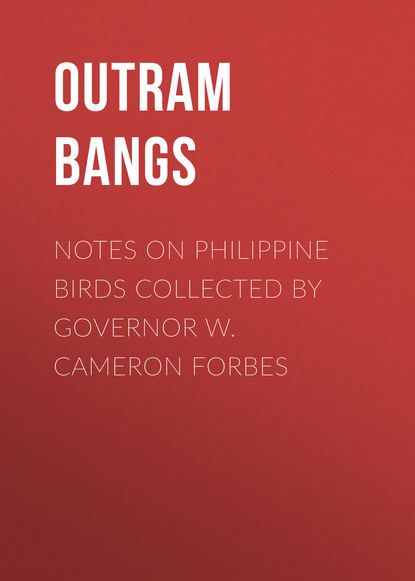По всем вопросам обращайтесь на: info@litportal.ru
(©) 2003-2024.
✖
Notes on Philippine Birds Collected by Governor W. Cameron Forbes
Настройки чтения
Размер шрифта
Высота строк
Поля
Aegithina tiphia aequanimis, subsp. nov
Nine specimens, both sexes, from Palawan and Dumaran Islands, June, July, August, and September.
Type. – M. C. Z. 64,334 adult ♂, Puerto Princesa, Palawan Island, 4 August, 1913. W. Cameron Forbes.
Characters. – Similar to A. tiphia tiphia (Linné) and A. t. viridis (Bonaparte) of Borneo, but bill longer and heavier; the upper parts much more yellowish olive-green and the forehead, including the lores, broadly bright yellow.
Measurements.
Remarks. – The Palawan and Dumaran bird represents a very good form, easily separated from A. tiphia tiphia or A. t. viridis by its larger bill and much brighter upper parts. The series shows no individual variation, and no tendency to ever become dusky or black above.
Orthotomus ruficeps nuntius, subsp. nov
Three specimens from the Sulu Archipelago; an adult ♂ Sibutu, 23 August, an adult ♂ Cagayan de Sulu, 2 July, and an immature ♀ Jolo, 2 August.
Type. – M. C. Z. 57,529 adult ♂, Cagayan de Sulu, 2 July, 1911. W. Cameron Forbes.
Characters. – Similar to O. ruficeps ruficeps (Lesson), (specimens from Borneo), but slightly larger, with longer bill; upper parts clearer gray; crown slightly deeper brown.
Measurements.
Remarks. – There are, in the U. S. N. M., three skins from Sibutu similar in all respects to ours.
Birds from Palawan and Clulion Islands are somewhat smaller than those from Sulu, but agree in color more nearly with them, than they do with true ruficeps of Borneo.
Zosterops forbesi, sp. nov
Two adult males from Camiguin Island, 2 August, 1921.
Type. – M. C. Z. 86,369 adult ♂, Camiguin Island, 2 August, 1921. W. Cameron Forbes.
Characters. – Similar to Z. basilanica Steere, but larger; upper parts much brighter and yellower, – yellowish citrine rather more strongly yellowish on head and upper tail coverts; yellow of under parts brighter and clearer – bright yellow chrome.
Measurements.
Remarks. – This new form which is well marked and quite distinct, belongs in the group characterized by possessing a wide stripe of yellow along the median under parts and gray sides and flanks. In the Philippines this group is represented by:
1. Zosterops siquijorensis Bourns & Worcester. Negros, Siquijor.
2. Zosterops boholensis McGregor. Bohol.
3. Zosterops everettii Tweeddale. Cebu.
4. Zosterops forbesi Bangs. Camiguin.
5. Zosterops basilanica Steere. Basilan, Bongao, Dinagat, Leyte, Mindanao, Papahag, Samar, Jolo, Tawi Tawi.
I have given the new form, which is named in honour of Governor W. Cameron Forbes, specific rank because in an enormous genus, largely composed of island forms, like Zosterops, I do not know where to draw the line between species and subspecies and much prefer leaving the question to be decided by some future reviewer of the genus.
Zosterops meyleri McGregor also of Camiguin Island, is a small species with wholly yellow under parts, belonging in a different group of the genus.
Oriolus xanthonotus persuasus, subsp. nov
Four adults, both sexes, Palawan, August.
Type. – M. C. Z. 64,180 adult ♂, Puerto Princesa, Palawan Island, 14 August, 1913. W. Cameron Forbes.
Characters. – Similar to O. xanthonotus xanthonotus Horsfield of Java, but larger with longer tail. Adult ♂ differing in color in much more heavily striped under parts and in the black of chest extending farther backward to include the upper breast; and much less sharply defined posteriorly against the white under parts; back more greenish yellow; yellow spot on outer tail feather large. The adult ♀ besides differing, as does the ♂, in heavier stripes below etc., has the whole pileum, occiput, upper neck, and sides of neck heavily streaked black and olive-green, and the throat and chest dull gray with whitish streaks. (A ♀ probably an older bird in the U. S. N. M. has the head neutral gray with an olive wash, very conspicuously streaked with black, the black streaks extending as in the others right to base of bill).
Measurements.
Remarks. – The Black-headed Oriole has been recorded from Palawan and Calamianes Islands only in the Philippines. The Palawan representative form is strongly marked and easily to be distinguished from O. x. xanthonotus of Java.
The bird of Borneo may represent still another form, distinguished from true xanthonotus by slightly smaller size, the under parts less purely white, that is, much more suffused with yellowish or yellowish ochraceous, sometimes even with grayish and with the yellow tail-spots larger. This form probably should be known as Oriolus xanthonotus consobrinus Wardlaw-Ramsay (P. Z. S., 1879, p. 709, N. E. Borneo). Everett, however, (Birds of Borneo 1889, p. 119), in mentioning the type states that "It is dissimilar from all known immature individuals of O. xanthonotus and belongs rather to the O. steerii group." If this is true and there is in north Borneo a form of the Philippine group of Orioles, with the sexes alike in plumage and with the throat and chest plain gray, then the form of the Black-headed Oriole of Borneo, if recognized, should be named.
In old females from Java the pileum and cheeks are dark mouse-gray, blackish on the forehead, the black streaks narrow, almost obsolete and noticeable on the crown and occiput only. Females from the mainland and Borneo and Sumatra also, when adult, have faint blackish streaks on the crown. In immature plumage the head is wholly unstreaked, which I doubt to be the case in the Palawan form.





